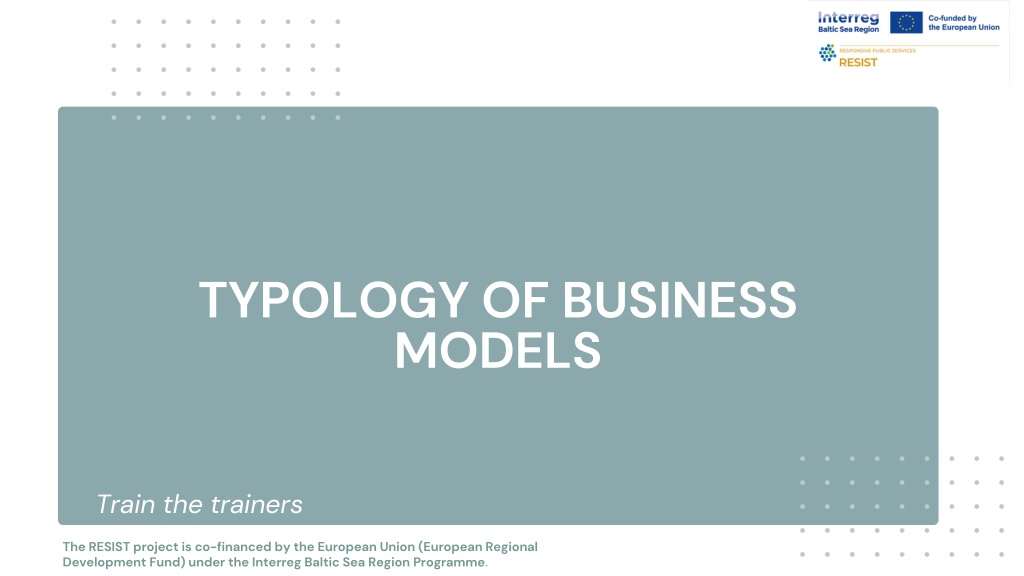
Understanding Business Models in Social and Conventional Enterprises
Explore the difference between social and conventional business models, their significance, operational structures, and value creation. Learn how social enterprises focus on a social mission while conventional enterprises prioritize profitability. Discover the impact of business models on customer value and organizational coherence.
Uploaded on | 0 Views
Download Presentation

Please find below an Image/Link to download the presentation.
The content on the website is provided AS IS for your information and personal use only. It may not be sold, licensed, or shared on other websites without obtaining consent from the author. Download presentation by click this link. If you encounter any issues during the download, it is possible that the publisher has removed the file from their server.
E N D
Presentation Transcript
TYPOLOGY OF BUSINESS MODELS Train the trainers The RESIST project is co-financed by the European Union (European Regional Development Fund) under the Interreg Baltic Sea Region Programme.
01. 02. DEFINITION AND SIGNIFICANCE OF BUSINESS MODEL DIFFERENCE BETWEEN SOCIAL AND CONVENTIONAL ENTERPRISE 03. INTRODUCTION TO SOCIAL ENTREPRENEURSHIP 04. NTRODUCTION TO SOCIAL ENTREPRENEURSHIP TABLE OF CONTENT 05. BUSINESS MODELS
Definition: A business model defines how a company creates, delivers, and captures value. It's a blueprint that outlines the way a company generates revenue, delivers products or services to its customers, and how it manages its resources. What is a Business Model? Value Proposition: What unique value does the company offer to its customers?
THE SIGNIFICANCE OF BUSINESS MODELS OPERATIONAL STRUCTURE: VALUE CREATION: ALIGNMENT: Business models are critical as they determine how a company creates value for its customers. The model impacts product or service design, experience, and ultimately, customer satisfaction and loyalty. A model ensures that aspects of the company are aligned common goal, facilitating strategic decision-making and fostering organizational coherence. well-defined business The chosen business model influences the company's structure, including processes, tasks, and the flow of information. dictates the strategies efficiency and effectiveness. all its towards a It customer operational that drive
The difference between social and conventional enterprise
Purpose and Objectives CONVENTIONAL ENTERPRISE: The primary goal is to generate profit for the owners or shareholders. While they may engage in social responsibility initiatives, these activities are often secondary to the main objective of SOCIAL ENTERPRISE: The primary purpose is to address a social issue or fulfil a social mission. While they aim to be profitable or financially sustainable, their main goal is to generate a positive impact on society, the environment, or both. Profits are typically reinvested into the social mission. financial gain.
Profit Distribution CONVENTIONAL ENTERPRISE: Profits are distributed to shareholders or reinvested into the business to drive growth, improve competitive positioning, and increase shareholder value. SOCIAL ENTERPRISE: Profits are mainly reinvested back into the business or directed towards their social mission. This supports the and expansion of their social impact. reinvestment sustainability
Decision-Making CONVENTIONAL ENTERPRISE: Decisions are primarily driven by financial considerations, market competitiveness, and shareholder value. SOCIAL ENTERPRISE: Decision-making is often guided by the enterprise s social mission and the impact on its beneficiaries. Financial viability is considered with a view towards sustaining the social mission.
Performance Measurement CONVENTIONAL ENTERPRISE: Success is measured by financial performance indicators such as revenue, profit margins, and return on SOCIAL ENTERPRISE: Success is measured not just in financial terms but also by the social impact achieved. Metrics may include social, environmental, and community impact alongside financial performance. investment.
Funding and Investment CONVENTIONAL ENTERPRISE: Typically funded through traditional means such as equity, debt financing, and reinvested profits. Investors seek a financial return on their SOCIAL ENTERPRISE: May access a mix of funding sources, including grants, social investment, and revenue from goods or services. Investors often expect a social return on investment (SROI) as well as, or instead of, a financial return. investment.
Stakeholder Engagement CONVENTIONAL ENTERPRISE: Stakeholders primarily include customers, employees, investors, and suppliers, with engagement strategies focused on maximizing customer satisfaction and shareholder value. SOCIAL ENTERPRISE: Stakeholders often include beneficiaries, community members, social investors, and other parties interested in the social mission. Engagement strategies may focus on collaborative impact and community involvement.
Market Orientation CONVENTIONAL ENTERPRISE: Market orientation is driven by demand, competition, and the pursuit of market share and profitability. SOCIAL ENTERPRISE: While they operate in the marketplace and may sell goods or services, their market orientation is often defined by the needs of their social mission, targeting underserved or disadvantaged groups.
In summary, the fundamental difference between social and conventional enterprises lies in their core objectives: social enterprises prioritize social impact alongside (or above) financial goals, while conventional enterprises focus on maximizing profit and shareholder value.
VALUE A viable business model is one that allows a business to charge a price for the value it s creating, such that the business brings in enough money to make it worthwhile and continue operating over time. PRODUCT SERVICE SHARED ASSETS SUBSCRIPTION LEASE/RENTAL INSURANCE BASIC AGENCY/ PROMOTION RESELLING
Social entrepreneurship is the process by which individuals, startups and entrepreneurs develop and fund solutions that directly address social issues. A social entrepreneur, therefore, is a person who explores business opportunities that have a positive impact on their community, society or the world.* *CO the U.S. Chamber of Commerce s digital platform for small business
Social entrepreneurship Scope and Impact Growing Trend Why It Matters Social entrepreneurs not only contribute to solving social problems but also inspire a shift towards more sustainable ethical business practices globally. Increasing recognition of the role of social entrepreneurship in solving global challenges has led to greater support from governments, investors, and the public. Covers a wide range of areas including education, protection, and community development. entrepreneurs work globally, targeting local issues with innovative solutions that can be scaled or elsewhere. healthcare, environmental Social and replicated
Key features of Social business models Non-dividend Distribution Financial Sustainability Social Problem Solving as Core Objective Profits are reinvested into the business or community, not paid out to shareholders. Maintains financial health to ensure long-term sustainability and ongoing social mission fulfilment. Every decision is guided by the mission to resolve a social issue, strategies and operations. shaping
10 MILLION Social Enterprises $2 TRILLION Annual Revenue 200 MILLION Jobs There are around 10 million social enterprises globally, united by the principle of putting purpose before profit. Social enterprises are generating around $ 2 trillion in revenue each year while creating positive impact. Social enterprises are creating 200 million jobs across various sectors, from agriculture to financial services. The world Economic forum The State of Social Enterprise 2024 https://initiatives.weforum.org/global-alliance-for-social-entrepreneurship/state-of-the-sector
Importance of Social Entrepreneurship Social entrepreneurship is increasingly recognized for its role in solving complex social issues that have been overlooked or inadequately addressed by other sectors. By fostering innovation and applying business principles to social problems, social entrepreneurs provide new pathways for societal improvement, offering hope and tangible benefits to communities worldwide.
Challenges Faced by Social Entrepreneurs Balancing Mission and Profitability Funding Measuring Impact Striking between social impact and financial sustainability can be challenging. the right balance Securing initial and ongoing funding without compromising the social mission. Developing metrics to measure social impact alongside financial performance. effective
FIELDS OF SOCIAL ENTREPRENEURSHIP Social entrepreneurship spans a wide range of fields, reflecting the diverse and complex nature of social challenges across the globe. Entrepreneurs in this sector apply innovative solutions to problems in various domains, aiming for a significant positive impact. Here are some of the key fields where social entrepreneurship is making strides: ENVIRONMENTAL SUSTAINABILITY EDUCATION HEALTHCARE SOCIAL JUSTICE AND HUMAN RIGHTS FOOD SECURITY AND NUTRITION SOCIAL INCLUSION BASIC ECONOMIC DEVELOPMENT TECHNOLOGY FOR SOCIAL GOOD ARTS AND CULTURE
A traditional business model refers to the way in which a company uses its resources and people to deliver products and services to customers and generate revenue. Traditional business models focus on the interaction between the company, its customers, and its products, and often involve strategies for advertising and promoting products to a broad audience.* *https://typeset.io/questions/what-is-a-traditional-business-model- 352tep08km
Conventional Enterprise Profit Orientation Market Participation Operational Efficiency Efforts are streamline reduce costs, and enhance productivity to maximize profitability. These businesses engage in competitive markets, striving to offer goods or services that meet consumer demand while outperforming competitors. The foremost objective is to achieve financial gain, with success measured through metrics such profit margins, and return on investment. Financial Investment and Returns made operations, to as revenue, Legal and Organizational Structure They operate within legal frameworks that define their structure, responsibilities, and the protection of investor and owner interests. Conventional attract investment based on their potential to generate financial returns for investors and shareholders. enterprises
Business models are fundamental frameworks that describe how a company creates, delivers, and captures value. They vary widely across different sectors and industries, reflecting the diversity in how businesses operate and generate revenue. In the following slides, several forms of business models that have gained prominence are presented.
BUSINESS MODELS SUBSCRIPTION MODEL SERVICE-BASED MODEL PRODUCT-BASED MODEL Description: Customers pay a recurring fee to access a product or service. This model emphasizes customer retention and predictable revenue. Example: Streaming services, software-as-a-service (SaaS) companies. Description: Companies create and sell physical goods. This model focuses on manufacturing, inventory, and distribution. Example: Consumer electronics manufacturers, apparel brands. Description: Rather than tangible products, companies provide services. This model relies on expertise, performance, and time. Example: Consulting firms, and cleaning services.
BUSINESS MODELS AFFILIATE MODEL FREEMIUM MODEL FRANCHISE MODEL Description: A company earns commissions by promoting other businesses products or services. This model relies on partnerships and marketing. Example: Affiliate bloggers, price comparison websites. Description: Franchisors license their business model and brand to franchisees, who then replicate the business in different locations. This model allows for rapid expansion. Example: Fast-food chains, retail brands. Description: Basic services are provided free of charge, while advanced features or premium services require payment. This model aims to convert free users into paying customers. Example: Many mobile apps, cloud storage services.
BUSINESS MODELS ON-DEMAND MODEL MARKETPLACE MODEL ADVERTISING MODEL Description: An intermediary platform that connects sellers with buyers, often taking a fee or commission for each transaction. This model scales by increasing the number of participants. Example: E-commerce sites, booking platforms. Description: Revenue is generated by displaying advertisements to users. This model often relies on high user traffic or engagement. Example: Media websites, and social networking platforms. Description: Products or services are provided on an as-needed basis, often facilitated by digital platforms. This model caters to immediate customer needs. Example: Ride-sharing services, and food delivery apps.
BUSINESS MODELS CROWDSOURCING MODEL SOCIAL SHARING ENTREPRENEURSHIP MODEL ECONOMY MODEL Description: Facilitates the sharing or renting of resources among individuals, often through a platform. This model emphasizes utilization over ownership. Example: Peer-to-peer lodging services, and car- sharing platforms. Description: Leverages the collective knowledge or skills of a crowd to solve problems, create content, or develop products. This model taps into community resources. Example: Crowdfunding platforms, open-source software projects. Description: Focuses on solving social, cultural, or environmental issues. While profit may be a motive, the primary aim is creating social value. Example: Social enterprises, cooperative organizations.
Summary of selected business forms and examples Attracts large user base Conversion to paid plans is crucial Freemium Model Offers basic services for free while charging for premium features. LinkedIn, Dropbox Lowers ownership costs Community-driven scalable Sharing Economy Model Facilitates peer sharing of access to goods and services. peer-to- TOMS Warby Parker Shoes, and
Summary of selected business forms and examples Attracts large user base Conversion to paid plans is crucial Social Entrepreneurship Model Offers basic services for free while charging for premium features. LinkedIn, Dropbox Balances social mission Innovative and impactful Sharing Economy Model Addresses unmet need or solves a social through a driven approach. a basic Airbnb, Uber profit and problem market-
Summary of selected business forms and examples Requires adherence to franchisor rules Built-in recognition Franchise Model Allows owners to operate a branch established brand. individual McDonald's, Subway of an brand Predictable stream Focus retention Subscription Model Customers recurring regular intervals for access to a product or service. pay price a at Spotify, Adobe Creative Cloud revenue on customer
The Business Model Canvas (BMC) is a strategic management tool used to visually depict the business model of an organization. It helps firms align their activities by illustrating potential trade-offs in a clear and structured manner. While the BMC framework is universally applicable across application and emphasis can vary significantly between social and conventional (commercial) entrepreneurship. business types, its Here s how the BMC typically differs between social and conventional entrepreneurship.
Customer Segments CONVENTIONAL ENTERPRISE: Targets customer segments that provide the most significant profitability and long-term viability for the business. The focus is primarily on market demand and spending power. SOCIAL ENTERPRISE: Focuses on serving underserved or disadvantaged groups who are often not the target market in traditional business models. The primary aim is to create social value for a community.
Channels CONVENTIONAL ENTERPRISE: Channels are selected based on efficiency, cost- effectiveness, and market reach, including retail outlets, online platforms, direct sales, wholesalers, etc. SOCIAL ENTERPRISE: Channels may include non- profit partnerships, community groups, social media, and other avenues that facilitate reaching a broader community or marginalized groups effectively.
Customer Relationships CONVENTIONAL ENTERPRISE: Focuses on customer retention and satisfaction to maximize repeat business. Relationships are often transactional, aimed at maximizing customer lifetime SOCIAL ENTERPRISE: Builds deeper, trust-based relationships focusing on community engagement and stakeholder involvement. The relationship often continues beyond the initial transaction to ensure lasting social impact. value.
Revenue Streams CONVENTIONAL ENTERPRISE: Revenue is primarily generated from sales of goods and services. Profit maximization is the typical focus, and financial sustainability is measured in terms of profit margins and returns on investment. SOCIAL ENTERPRISE: Revenue models in social enterprises might include donations, grants, sponsorships, and social impact investments, besides sales. Often, profitability is balanced with the necessity to achieve social goals.
Key Activities CONVENTIONAL ENTERPRISE: Includes activities that enhance product value, streamline operations, improve marketing effectiveness, and increase shareholder value. SOCIAL ENTERPRISE: Activities may include community training, advocacy, public education, and other actions that contribute to social welfare improvements.
Key Resources CONVENTIONAL ENTERPRISE: Focuses on financial resources, intellectual property, human capital, and physical assets that support the business's economic SOCIAL ENTERPRISE: Includes networks of volunteers, partnerships with NGOs, and community organizations, and access to governmental or non-profit funding. goals.
Key Partnerships CONVENTIONAL ENTERPRISE: Partnerships are formed with suppliers, distributors, and sometimes competitors, primarily to enhance profitability and market SOCIAL ENTERPRISE: Partners are often aligned with the mission and include other social enterprises, non-profits, community organizations, and sometimes governments. position.
Cost Structure CONVENTIONAL ENTERPRISE: Costs are optimized for financial efficiency and scalability. Investments are often directed towards innovation, marketing, and expansion activities that will directly generate revenue. SOCIAL ENTERPRISE: Costs are carefully managed to fund service delivery with limited resources. Budgets may include a significant allocation for community projects and outreach programs.
Value Propositions CONVENTIONAL ENTERPRISE: Primarily focused on customer satisfaction and economic value, such as quality, price, service, and brand image. The core is to offer competitive advantages that appeal to the customer's personal or business needs. SOCIAL ENTERPRISE: The value proposition revolves around social impact. For instance, it could involve providing affordable healthcare, and education, or improving environmental conditions. The goal is to address a social issue or meet a societal need that has been overlooked or inadequately addressed.
Business Model Canvas Osterwalder Business Model Canvas
BACKGROUND Alexander Osterwalder (1974-) Swiss entrepreneur and researcher developed the Business Model Canvas. It is a practical framework to help entrepreneurs, startups, and established companies to visualise and innovate their business model.
KNOW YOUR BUSINESS Key partnerships Who are your existing partners, and what is the value? Key activities What are the core activities in your business? Key resources What resources are needed to deliver activities? Who are your key personnel?
KNOW YOUR BUSINESS Value proposition What is your business about? What is unique about your business? What problem do you solve?
KNOW YOUR BUSINESS Customer relations What is your relationship with your customers like? Are they loyal, or irregular? Customer segments Who are your customers? Can you distinguish between them? Channels How do you reach and interact with your customers, both existing and potential?
KNOW YOUR BUSINESS Cost structure What are you paying for, and what are your key cost drivers? Revenue streams From where do you derive your income?
There is plenty of possibilities for collaboration... Osterwalder Business Model Canvas






















